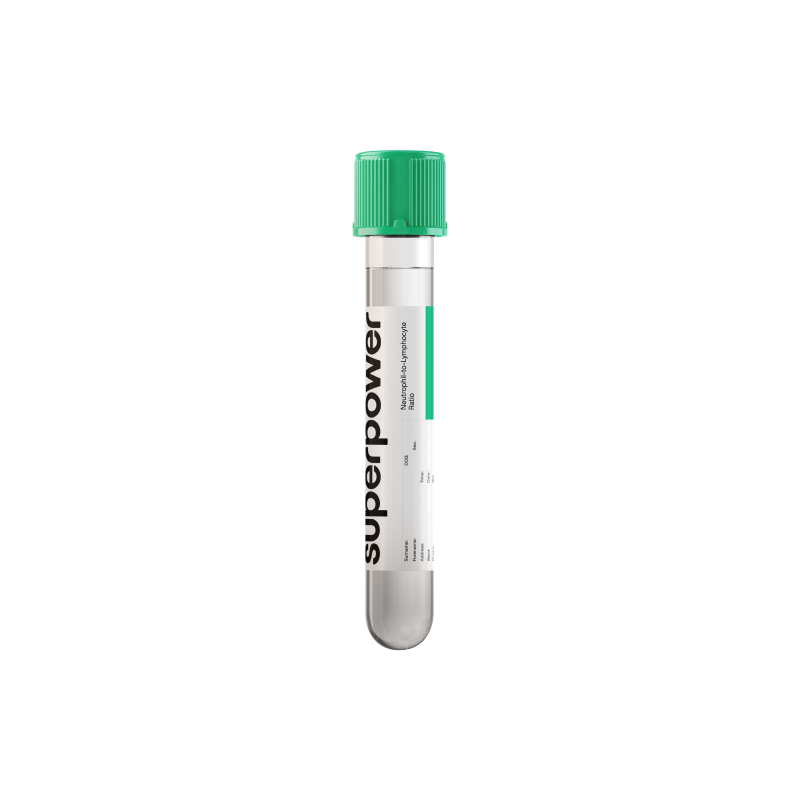NLR is calculated by dividing your absolute neutrophil count by your absolute lymphocyte count from a standard CBC. It reflects the balance between innate stress response and adaptive immunity.
Higher values signal inflammation or stress load, while lower values suggest relative lymphocyte predominance.
Key Benefits
- Spot whole-body inflammation by comparing neutrophils to lymphocytes in your blood.
- Flag acute infection or physiologic stress when the ratio rises above your baseline.
- Clarify symptoms by suggesting stronger bacterial responses versus typical viral patterns.
- Guide next steps when ill by pairing trends with CRP and exam findings.
- Track recovery after infection, flare, or surgery as the ratio moves back toward normal.
- Explain steroid or stress effects when lymphocytes fall and the ratio rises.
- Support prevention plans by highlighting possible low-grade inflammation to address early.
- Best interpreted with a full CBC, CRP, and your symptoms.
What is Neutrophil-to-Lymphocyte Ratio?
Neutrophil-to-Lymphocyte Ratio (NLR) is a simple index derived from a standard white blood cell count. It compares the number of neutrophils to the number of lymphocytes circulating in your blood. Neutrophils are short-lived, front-line infection fighters from the bone marrow that engulf microbes (innate immune granulocytes). Lymphocytes include T cells, B cells, and natural killer cells that coordinate targeted defense and immune memory (adaptive immune lymphocytes). By expressing neutrophils relative to lymphocytes, NLR condenses two major immune cell populations into one number.
What it reflects: the balance between rapid, nonspecific inflammation and targeted immune control. During acute injury or infection, neutrophils typically rise, while physiological stress hormones (catecholamines, cortisol) can transiently lower circulating lymphocytes by redistribution, so the ratio shifts. Conversely, during recovery, this balance can normalize as lymphocytes repopulate and neutrophil demand eases. Because of these dynamics, NLR functions as an integrative snapshot of systemic inflammatory activity and stress biology, offering a compact readout of how “activated” the innate arm is relative to the adaptive arm at a given moment.
Why is Neutrophil-to-Lymphocyte Ratio important?
The neutrophil-to-lymphocyte ratio (NLR) is a simple window into how your immune system is balanced between rapid “first responder” defense (neutrophils) and targeted, memory-driven defense (lymphocytes). Because inflammation underlies heart disease, infections, cancer biology, and recovery from stress or surgery, this ratio captures whole‑body inflammatory tone in a single number.
In adults, typical values cluster around 1–3, with an “optimal” feel toward the low-to-mid range, about 1–2, reflecting calm baseline inflammation and a robust adaptive immune reserve. Children often run lower because lymphocytes naturally predominate in early life. During pregnancy, NLR rises as neutrophils increase physiologically, so higher values can be normal by trimester.
When the ratio is on the low side, it can reflect lymphocyte predominance or reduced neutrophils. Viral infections and some immune conditions tilt it this way; true neutropenia raises risk for bacterial infections, mouth ulcers, and fevers, while many people feel fine if counts are only mildly shifted. In children, a low ratio is frequently a normal age pattern.
When the ratio is higher, neutrophils dominate and lymphocytes may dip—an imprint of acute stress, bacterial infection, trauma, surgery, corticosteroid effect, or chronic inflammatory states. People may experience fever, malaise, or pain depending on the cause. Persistently higher NLR has been linked to atherosclerosis burden, insulin resistance, and less favorable outcomes in cardiovascular disease and many cancers.
Big picture: NLR integrates the innate–adaptive immune balance with stress hormones, marrow output, and metabolic health. Alongside CRP, ESR, and blood counts, it helps map inflammatory load and forecast long‑term risks tied to chronic inflammation.
What Insights Will I Get?
The neutrophil-to-lymphocyte ratio (NLR) compares two white cell lines: neutrophils (innate, first responders) and lymphocytes (adaptive, memory-based defense). It shows how the immune system allocates energy between rapid, nonspecific defense and targeted immunity. Because stress hormones raise neutrophils and lower lymphocytes, NLR integrates inflammation and stress biology. Higher ratios relate to cardiometabolic strain, infection severity, cancer outcomes, and recovery capacity.
Low values usually reflect a relative abundance of lymphocytes or fewer neutrophils. This can signal robust adaptive immune tone, or arise with viral infections, reduced marrow output (bone-marrow suppression), an overactive spleen (hypersplenism), or autoimmune neutropenia. Children and younger adults tend to have lower ratios than older adults.
Being in range suggests balanced innate and adaptive immunity, quiet background inflammation, and stable neuroendocrine stress signaling. In healthy adults, optimal values generally sit toward the low-to-mid part of many laboratories’ reference interval, consistent with resilient vascular, metabolic, and immune function.
High values usually reflect a shift toward innate activation and physiologic stress—seen with bacterial infection, tissue injury, chronic inflammatory disease, cardiometabolic stress, malignancy, or glucocorticoid exposure. The ratio often runs higher in older adults, men, and during pregnancy. Systemically, this pattern accompanies blood vessel activation and a tendency toward clotting (hypercoagulability), insulin resistance, and fewer lymphocytes (relative lymphopenia), signaling reduced adaptive immune bandwidth.
Notes: NLR is a ratio, so extremes can result from changes in either neutrophils or lymphocytes; context and absolute counts matter. Acute illness, surgery, strenuous exercise, smoking, time of day (circadian timing), and medications (e.g., corticosteroids, beta-agonists, lithium) can shift NLR. Reference limits vary by lab; trends are informative.



.svg)



.png)
.png)
.png)
.png)








